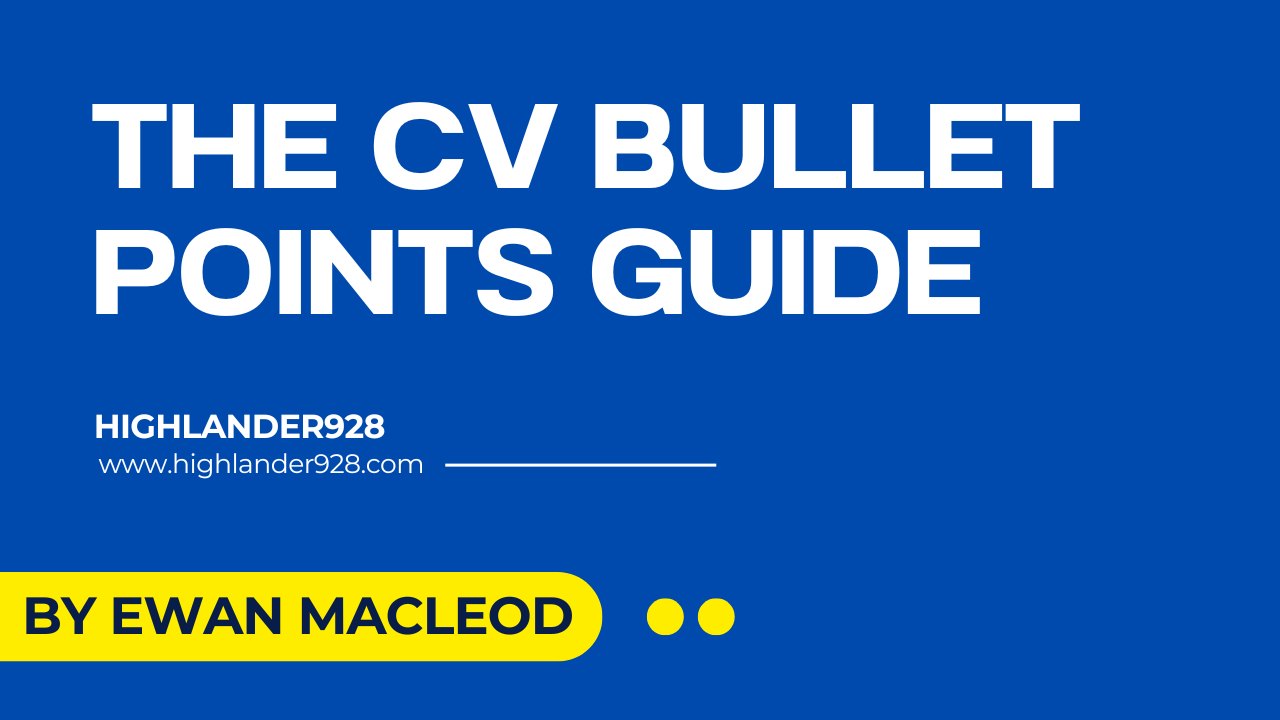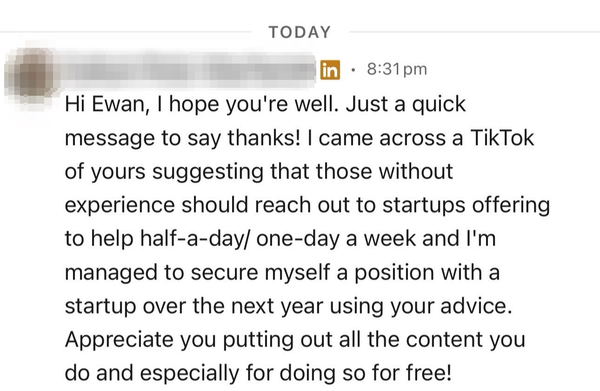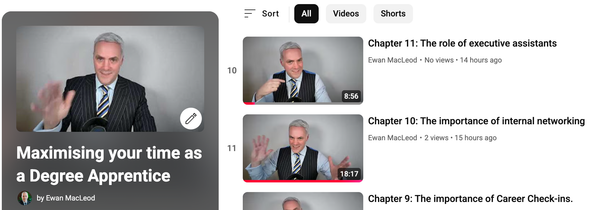Improving your CV bullet points: A detailed guide

At every TikTok Live when we're reviewing CVs, you'll regularly hear me saying words to the effect of, "These bullet points can be really improved" or "You're under-selling yourself with these bullet points."
I try and give some ideas there and then, but sometimes there are lots of people waiting for a review and I don't have the time to elaborate, so I've written this post to try and do that.
What do you mean by 'bullet points?'
I mean in the experience section of your CV – where you're listing your recent work experience. Under each experience section, employers generally expect to see a description of the work and by convention, this description is usually delivered through a series of sentences arranged in bullet point format.
What's the function of bullet points?
It's to summarise – and to enable the reader to rapidly scan your experience to try and establish a picture of you and what you offer. Occasionally, I'll see some CVs that are comprised of sentence after sentence – a wall of text! This can be enormously difficult to quickly scan.
Why is this needed?
Typically speaking, hiring managers are keen to receive a variety of CVs from potential candidates. Indeed, there's nothing worse as a hiring manager when you only get a handful of CVs sent in for a particular position. Each hiring manager naturally wants a choice of candidates irrespective of the position. They want to feel they've got a great selection to choose from. So they'll be expecting or encouraging a good amount of CVs.
In today's economy, there are often a lot of people looking for jobs and therefore hiring managers aren't lacking for choice. If anything, it could be argued that they've got too much choice. When they open the folder, menu or system to look at prospective candidates, the list of CVs can often run into the tens, hundreds, or in some cases, thousands!
Looking through CVs
When that hiring manager sits down to look at the first batch of CVs, that's when you need your bullet points to be ready! If there are a lot of CVs to browse through, then they'll be giving your document just a few moments (in some cases, just seconds!) to scan initially. Everyone does it differently – but this is where you have the opportunity to really put your best foot forward and make sure these bullet points offer a great picture of your capabilities.
Remember, we're not just talking about one hiring manager, either. Every organisation is different, but it helps to imagine that, for example, your document might potentially be read by 4-5 people before you get a response. (For example: Initial HR flick through, middle/senior HR scan, team manager review, hiring manager review.)
Which brings us to bullet points.
The functions of a bullet point
In my view, experience bullet points have the following functions:
- Scannable: They need to be scannable by the hiring manager [or whoever it is at the company]. They have to be able to quickly run their eyes across your document and swiftly take in keywords and phrases that they're expecting to see to justify further review.
- Readable: When the hiring manager(s) sit down and actually read your CV, the bullet points need to make sense. They should build on each other to create a great overview of the responsibilities, skills and capabilities you've brought to the position – along with some good, illustrative outcomes.
- AI Friendly: Some organisations will make use of automatic CV scanning tools and in this case, you want the AI engine to get the best impression of you. Don't bother trying to game the system by including hundreds of keywords – it's typically something a bit like ChatGPT that they're using, so pretty advanced. If they're going to use AI to summarise your CV, you need to have good content initially to help reach the conclusions you're aiming for.
Writing bullet points is difficult
It's generally a frustrating and annoying process, trying to document your experience with brilliant bullet points. It needs energy, tenacity, imagination and focus.
Too often, though, this is the area that gets the least amount of effort from candidates – precisely because it is difficult. This is where I think you should put maximum effort though!
Some candidates like to begin by looking at their existing job descriptions to give some inspiration – that can be a good idea, but don't just cut and paste it (I have seen this quite often).
Bullet Point Inspiration
Here are some prompts to help get you started if you're sitting staring at a blank screen:
Quantifiable Impact
- What metrics improved under your watch? By how much?
- How many people/clients/customers did you serve or manage?
- What percentage of time/money/resources did you save?
- How much revenue did you generate or help secure?
- What was the scale of projects you managed (budget, team size, timeline)?
- How did you exceed targets or expectations (and by what margin)?
Problem-Solving
- What specific problems did you solve that were causing issues?
- What challenges did you overcome that others couldn't?
- How did you turn around a difficult situation?
- What innovative solutions did you implement (to achieve what outcomes)?
- Did you do anything that helped to prevent potential issues from arising?
Leadership Points
- How many people were you supervising? (Believe it or not, team size is one of the most missed aspects in many CVs I review!)
- How did you influence others without direct authority? (i.e. when you weren't the line manager)
- What cross-functional initiatives did you lead or contribute to?
- How did you mentor or develop team members?
- What relationships did you build that created new opportunities?
- How did you improve team performance or morale?
Skills & Knowledge
- What specific knowledge did you apply that others didn't have – or were perhaps new to the organisation or team?
- What tools or technologies did you master to improve outcomes?
- What complex information did you simplify for others?
- How did you help others with training or knowledge sharing/transfer?
- How did you stay ahead of industry trends or changes?
Initiative & Innovation
- What things did you start that didn't exist before? (Initiatives, processes, policies, methods)
- Where did you volunteer for responsibility beyond your job description? Or beyond standard expectation?
- What processes did you automate or streamline? Say how and what the outcomes were.
- How did you approach old problems in new ways?
Client and Customer Impacts
- How did you improve customer satisfaction or retention? Think methodologies, approaches, techniques, policies – or anything involving data.
- What feedback did you receive from clients or stakeholders? Is that quantifiable or demonstrable (e.g. "Employee of the month, 3 times")
- How did you turn around difficult client relationships? (Even if it felt easy to you, it's still evidence of you delivering!)
- What customer needs did you identify that others missed? Or others had not addressed?
- How did you exceed client expectations?
Strategic Contributions
- How did your work align with or advance the company's goals?
- What long-term impact will your contributions have? (e.g. "... resulting in a 60% increase in order fulfilment ongoing")
- How did you help position the company/department/team for future success?
- What strategic insights did you provide that influenced decisions? How did you arrive at those insights?
- How did you help expand into new markets or customer segments?
Personal Growth
- What new capabilities have you developed in this role? (Even if it felt simple or easy to you, it's still worth noting it.)
- What areas of expertise have you developed or enhanced? (Formal or informal)
- How have you adapted to changes or challenges? (Don't forget about unexpected results or unforeseen issues that might have occurred)
- How have you demonstrated resilience or flexibility? Often this can be a great topic for a bullet point.
Don't Forget Context and Relevance
- How was your achievement unusual or significant for your industry?
- What constraints or limitations did you work within? (Budgets, staff numbers, or specific industry regulations)
- How does this achievement relate to your target role? (The one you're applying for)
- Why would your future employer care about this particular accomplishment?
- What does this achievement demonstrate about your work style or values?
Using AI to get bullet point inspiration
One of my favourite techniques for trying to get inspiration for good bullet points is to use ChatGPT/Claude or similar. I don't mean to write them for you. No. I think you should do this. But because they have such 'knowledge' encoded across their vast databases, they can be incredibly helpful in suggesting ideas.
So, for example, if you're were a 'Digital Business Analyst' in your current role, you can ask the AI to 'suggest some CV bullet points for the work I've been doing'.
It won't know the answer at all, of course. It will just make some stuff up.
But... and this is the science bit – SOME of its output is likely to trigger some ideas and inspiration for you.
You can then throw in your existing 4 bullet points (for example) and ask it to suggest 10 more. Again, a lot of it will be nonsense, but it's likely to suggest interesting and useful phrases that will jog your memory and get your brain cells connecting for useful ideas to document as bullet points.
Anatomy of a good bullet point
My favourite format for bullet points looks like this:
[ Two-word summary in bold ]: [ Explanation followed by some kind of 'resulting in' evidence, across a maximum of two sentences. ]
I like this approach because you are deliberately summarising the bullet with two words – you're marking them in bold to draw the eye – and as I'm scanning down the list of bullet points, if/when I see something that interests me, I can immediately scan across and ideally start reading.
Here's a made-up example:
SQL Scripting: Created 100+ SQL queries to drive the Disney end user reporting system using Microsoft SQL Manager Lite, enabling live data production services for Disney+.
or, a less technical one:
Employee Award: Awarded CEO’s Commendation for the creation and implementation of the Disney+ data reporting lake capability system and its launch within 90 days.
Outcomes, outcomes, outcomes
It's ideal if you can try and ensure there's some kind of outcome – a 'why does this matter?' aspect – for every single bullet point. This might involve some kind of metric (e.g. 'within 90 days') or any kind of measurement that's time-bound, specific or meaningful. It's ok if it's an intangible benefit or outcome but try and include some kind of metrics.
Be careful with too many percentages
I frequently will give feedback during a Live whereby I say 'Please try and include some outcomes' and then a few days later, the individual will return with percentages in every single bullet point. This is ok. Buuuuuuut there's a believability aspect to consider. With too many percentages, the bullet points can feel a little forced and then there's a risk the reader starts to doubt them. Your bullet points should never be creative or point-blank-made-up but how you present them and what metrics you use is important. So even if the only metric you've got is a percentage, it's often worthwhile varying things somewhat to use other numerical values.
Volume of bullet points
Always, always prioritise experience bullet points over everything else in my view. Hiring managers are looking for great people – and we want you to be on their radar as an amazing find! One of the best ways of doing this is by making sure that IF they do look at your CV, they are impressed by your experience. You typically achieve this by having great bullet points – and lots of them!
So, for example, I'd rather read a few more bullet points about your work experience than detailed descriptions of the courses you've done at University, or lots of detail about your interests.
Likewise, I always worry about the amount of space that candidates use for their personal statements. I'd prefer an ultra-brief summary (say, 2 lines maximum) and use the rest of the space you've saved to add extra bullet points into your experience.
Give some thought to how many bullet points you include per experience section. For example, some people will quickly equate the number of bullet points in a given section to all sorts of their own subjective metrics. I've seen some CVs where three internships were presented, the most recent with 2 bullet points of experience, and the other two with 3 bullet points – and then had colleagues assume that this is because the candidate is embarrassed or concerned about the work they achieved in that role. Often the candidate is completely oblivious to how they're being 'measured'.
It's amazing how quickly CVs become a reflection of a candidate, simply by the style and arrangement. For example, I've often been in meetings where we're discussing candidates, and someone will invariably say, 'I think this CV has more experience'. What they mean is that the candidate happened to include 8 bullet points covering their last role compared to the other CVs. So, a CV can often be assigned the (potentially highly inaccurate) status of having 'the most' (and therefore 'the best') experience when really, the actual candidate is no different from another whose CV happens to only have 2 two bullet points for their latest experience section.
There is no right or wrong answer here - it is soooo subjective and nuanced. My own approach is to prioritise more bullet points for the most recent experiences.
Don't waste bullet point space
If you're aiming to get into investment banking or become a project manager, and you've got some brilliant, relevant work experience, you don't need to give us 5 bullet points about your experience working in McDonald's, being a food delivery driver, or stacking shelves at a supermarket. These kinds of experiences are well understood by hiring managers – and most would rather read about your relevant experience. You don't need to give every experience the same number of bullet points – and you don't need to include every single work experience, especially when it was years ago or when it was whilst you were a student.
Tailor your bullet points
When I talk about tailoring bullet points, I tend to get two broadly negative reactions:
- That's too much work/hassle - can't I just have a single CV? Yes, that's ok - you're just leaving it to the hiring manager to decide whether you're a fit. I prefer to avoid leaving things to chance here as there are already so many unknown variables with this whole process.
- Isn't this a bit like lying? I'm always surprised by this one – I think it stems from a belief that you should have one standard CV or one record of the truth. The reality is very different, though. Tailoring bullet points to a particular role is not lying – one should never lie on a CV. Instead, you should make sure the hiring manager understands your capabilities as best as possible. So often this will involve modifying bullet points to highlight specific capabilities or features that you had not previously focused on.
For example, if a job advertisement is asking for candidates who have experience working with Microsoft 365, you might consider modifying one or two bullet points to explicitly mention this and give an example of the work you've done in that area.
AI and Scanning
Don't overthink things when it comes to AI. I regularly get lots of questions about "ATS" – applicant or application tracking systems which make use of keyword scanning or AI analysis. Many of the big companies I know still use these hulking, creaking software monoliths originally programmed back in the 1980s – and these are glorified CV-upload systems. Organisations that are more modern and nimble will often have the latest tech – and this will invariably include some kind of AI technology.
It is a hiring manager's dream to be able to accurately and reliably sift through hundreds of CVs in seconds and be able to rapidly identify the dream candidate(s) to interview – and every career software vendor is seeking to offer something like this. It's still an enormously difficult ask to identify brilliant candidates automatically, especially when job descriptions are often so badly written by companies.
Nowadays, if there is an AI being used - either automatically or manually – you can expect something like ChatGPT to scan your submission and give a summary to the team. So if you want to know what it's thinking of your current document, you can simply ask it.
I don't think it's worthwhile trying to game the system, to try and trick it into prioritising your CV. In days gone by I'm sure it might have been useful to include dozens of keywords in white text hidden at the bottom of your CV. Today's AI is way, way more advanced to be fooled by this – and could end up highlighting this attempt to the hiring manager. There are so many variations and nuances that I think it's better just to submit a good CV and see how things go.
CV Format
Just a quick note on CV formats. My preference is to avoid any CV style with columns – because it forces you into using smaller space to explain your bullet points... which is precisely the basic function of a CV!
Have a look at your CV format as it stands right now: If it's two-column, you're probably forcing yourself (or, enabling yourself?) to have fewer bullet points for every experience section. There's no right or wrong answer here, but consider how your CV will look next to another CV that's using the whole page to get the candidate's experience across.
Skills
I'm no fan of simply listing skills on a CV, simply because this doesn't give the hiring managers any context whatsoever about what you can DO with that skill.
Simply listing 'SQL Server' or 'Python' really doesn't help me understand whether you've done anything with that skill at all.
So, if you've put a lot of work into listing out a whole load of skills – technical or otherwise – let me challenge you here to make sure that each of those skills is reflected, mentioned or discussed somehow in your bullet point experience.
This is often a great place to start. When I'm working with people to help improve and iterate their CVs, this is often where I'll begin. I'll ask 'So what did you do with SQL Server' and then if the candidate starts pouring out ideas, memories, use cases and examples, we'll then construct this into a series of bullet points.
Likewise, if the answer is, "SQL Server? Oh I didn't do much at all, I don't know it that well," then is it worthwhile even including it as a skill? OR is this an example of something that you really should actively improve through training or certification? Either way, it's useful to give some thought to this.
Bullet Point Examples
Here are some before-and-after bullet point examples showing how you can really develop even the most mundane 'tasks' into sentences that can readily showcase your capabilities.
So, instead of:
- Managed calendars and scheduled meetings
Consider something like:
- Calendar management: Coordinated complex schedules for 4 executives with 60+ weekly meetings, reducing scheduling conflicts by 90% and freeing up 5+ hours weekly.
Instead of:
- Answered phones and greeted visitors
Consider something like:
- Visitor experience: Redesigned reception protocol to create a more welcoming atmosphere, resulting in positive comments from 85% of visitors and improved company image.
Instead of:
- Organised files and documents
Consider:
Office efficiency: Reorganised filing system for 5,000+ documents, creating a digital index that reduced document retrieval time from 15 minutes to under 2 minutes.
Instead of:
- Ordered office supplies
Consider:
- Resource optimisation: Implemented a new inventory system for office supplies that reduced waste by 32% and saved approximately £6,000 annually.
Instead of:
- Prepared reports and presentations
Consider:
- Executive support: Prepared 20+ professional presentations monthly for C-level meetings, consistently receiving praise for quality and attention to detail.
This is version 1 published on 30th March 2025: I intend this post to be a work in progress so I'll aim to add more points as I think of them.
Can I help you?
- If you need any help with your CV, you are very welcome to submit your CV during one of my TikTok Live events and I'll try and give you some free real-time perspective. Please follow me for updates on when I'm going live.
- If you'd like me to do a CV Video Review of your CV, check out my gig on Fiverr.
- I've made a 29-episode video course called Improving your CV.
- And if you'd like to book some time with me, I offer 1:1 sessions.
- All my TikTok subscribers get access to my exclusive Discord channel to discuss their careers with me (1:1) and with the other subscribers. You can subscribe via Highlander928 on TikTok.
- I aim to try and respond to direct messages on TikTok so if you've got any questions, try me.


